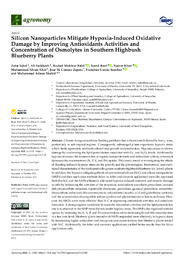Por favor, use este identificador para citar o enlazar este ítem:
https://hdl.handle.net/11000/33470Registro completo de metadatos
| Campo DC | Valor | Lengua/Idioma |
|---|---|---|
| dc.contributor.author | Iqbal, Zafar | - |
| dc.contributor.author | Sarkhosh, Ali | - |
| dc.contributor.author | Balal, Rashad Mukhtar | - |
| dc.contributor.author | Rauf, Saeed | - |
| dc.contributor.author | Khan, Naeem | - |
| dc.contributor.author | Altaf, Muhammad Ahsan | - |
| dc.contributor.author | Cámara-Zapata, José-María | - |
| dc.contributor.author | Garcia-Sanchez, Francisco | - |
| dc.contributor.author | Shahid, Muhammad Adnan | - |
| dc.date.accessioned | 2024-10-11T12:15:52Z | - |
| dc.date.available | 2024-10-11T12:15:52Z | - |
| dc.date.created | 2021-10-26 | - |
| dc.identifier.citation | Agronomy 2021, 11(11), 2143 | es_ES |
| dc.identifier.issn | 2073-4395 | - |
| dc.identifier.uri | https://hdl.handle.net/11000/33470 | - |
| dc.description.abstract | Climate change exacerbates flooding problems due to hurricanes followed by heavy rains, particularly in sub-tropical regions. Consequently, submerged plants experience hypoxia stress which limits agronomic and horticultural crop growth and production. Hypoxia causes oxidative damage by accelerating the lipid peroxidation associated with O2- and H2O2 levels. Additionally, hypoxia increases the accumulation of organic osmoprotectants and antioxidant activity, whereas it decreases the macronutrient (N, P, K, and Zn) uptake. This study aimed at investigating the effects of flooding-induced hypoxia stress on the growth and the physiological, biochemical, and nutritional characteristics of the hydroponically grown southern highbush blueberry (cv. Jewel) plants. In addition, the hypoxia-mitigating effects of conventional silicon (Si-C) and silicon nanoparticles (SiNPs) and their application methods (foliar vs. foliar and rootzone application) were also appraised. Both the Si-C and the SiNPs efficiently alleviated hypoxia-induced oxidative and osmotic damage to cells by enhancing the activities of the enzymatic antioxidants (ascorbate peroxidase, catalase, dehydroascorbate reductase, superoxide dismutase, peroxidase, guaiacol peroxidase, monodehydroascorbate, reductase); the non-enzymatic antioxidants (ascorbic acid and glutathione contents); and the accumulation of compatible solutes (proline and glycinebetaine) in leaves and roots. However, the SiNPs were more effective than Si-C at improving antioxidant activities and osmolytes formation. A strong negative correlation between the antioxidant activities and the lipid peroxidation rate was observed in the SiNP-treated plants under hypoxia stress. The SiNPs also regulated nutrient uptake by increasing the K, N, P, and Zn concentrations while decreasing Fe and Mn concentrations to a less toxic level. Blueberry plants treated with SiNPs responded more effectively to hypoxia stress by maintaining higher antioxidant and osmoprotectant concentrations than blueberry plants treated with Si-C. Additionally, the foliar and rootzone applications yielded better results than the foliar applications only. | es_ES |
| dc.format | application/pdf | es_ES |
| dc.format.extent | 18 | es_ES |
| dc.language.iso | eng | es_ES |
| dc.publisher | MDPI | es_ES |
| dc.rights | info:eu-repo/semantics/openAccess | es_ES |
| dc.rights | Attribution-NonCommercial-NoDerivatives 4.0 Internacional | * |
| dc.rights.uri | http://creativecommons.org/licenses/by-nc-nd/4.0/ | * |
| dc.subject | Abiotic stress | es_ES |
| dc.subject | Biochemical response | es_ES |
| dc.subject | Carboxylation efficiency | es_ES |
| dc.subject | Lipid peroxidation | es_ES |
| dc.subject | Nutrients | es_ES |
| dc.subject | Photosynthesis | es_ES |
| dc.subject | Physiological response | es_ES |
| dc.subject | Quantum efficiency | es_ES |
| dc.subject | Stomatal conductance | es_ES |
| dc.title | Silicon Nanoparticles Mitigate Hypoxia-Induced Oxidative Damage by Improving Antioxidants Activities and Concentration of Osmolytes in Southern Highbush Blueberry Plants | es_ES |
| dc.type | info:eu-repo/semantics/article | es_ES |
| dc.relation.publisherversion | https://doi.org/10.3390/agronomy11112143 | es_ES |

Ver/Abrir:
agronomy-11-02143-v3-2.pdf
2,73 MB
Adobe PDF
Compartir:
 La licencia se describe como: Atribución-NonComercial-NoDerivada 4.0 Internacional.
La licencia se describe como: Atribución-NonComercial-NoDerivada 4.0 Internacional.
.png)